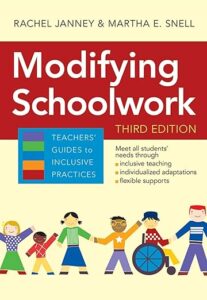
Special Education Guide: The Difference between Accommodations and Modifications
So you have a student that isn’t doing well. Your school uses some version of the RTI model, and you’ve tried to help them in the classroom. But, no matter what you do, they still are struggling so your Child Find team decides its time to explore special education. You start hearing words thrown around like “accommodations” and “modifications,” but you’re not quite sure the difference. Aren’t they both kind of the same thing?
No, they’re not. Accommodations are the basis of a 504 plan, and Modifications are the basis of “specialized instruction” or an IEP. Here’s why:
Accommodations:
Let’s start with accommodations. Accommodations are things that you put in place that help a student access the curriculum.
Common accommodations that I see a lot are; preferential seating, copies of notes, shortened homework.
These are all things that can be provided in the general education class by the general education teacher. (I hate the term “regular ed” so you will never see me use it, but that’s beside the point)
If you are new to teaching or are a parent let me explain:
Preferential Seating:
Giving the student a specific place to sit in the class. Often people assume that this means front and center, and sometimes it does. But not always.
I have had students that were easily distracted, so I put them in the front but in the corner away from the door, so they weren’t distracted by people coming and going.
There have been students in my classes that really needed to get up and move during class. I have advised teachers to put these kids in the back, so they can stand as needed and not distract everyone else. For these students there were clear guidelines as to what standing and moving looked like so that they didn’t throw off the whole class.
Preferential seating can be anywhere that you decide would benefit the student and this should be defined in their IEP or 504 to make it clear to future teachers.
Copies of Notes:
For students who have OT difficulties, organization difficulties, or attention struggles, I sometimes decide that they would benefit from copies of notes.
For these students, they are still expected to take notes during the class to ensure that they are doing their best to pay attention. But after the class is over, they are provided with copies of notes. This way they can compare what they took down to what they should have taken down and learned from the differences.
For paraprofessionals, they are not given the time during the day often to prep and prepare notes, so I instruct them to either take a copy of the teacher’s notes or if unavailable, to take a copy of a model student’s notes. But to quickly check it over and add anything missing. This way they can still pay attention to the other students in the class and not have to ignore them while the para takes notes.
Shortened Homework:
This is debated upon in my school. Is shortening the homework an accommodation or a modification? I think it is an accommodation because you are not changing the difficulty of the homework, you are just cutting down the number of problems for students who take hours to complete 20 minutes of homework.
Modifications
Where an accommodation is helping a student access the curriculum, a modification is when you change the curriculum itself. When you have a student that is working below grade level, and you have to modify the curriculum that they are learning so that they can make effective progress.
Accommodations can be provided through a 504 plan. But, once modifications get involved, the way I understand it is that now an IEP has to be written.
Modifications are things like; changing the vocabulary/spelling list from 20 to 10, creating an alternate assessment, working on different content altogether.
Changing the spelling list:
By giving a student a list of 10 words instead of 20, you are adjusting what the student is being expected to learn. Another alternative to this is if you give them a completely different list of words. Words that are achievable for them.
Creating an alternate assessment:
This is one that I have to do a lot, especially in math. For example, a teacher may give a test on solving equations where the students are expected to be able to go up to 5 or 6 steps. I may make a modified test where they are only expected to be able to do 2-4 steps. Now I have modified the performance expectation of the student.
Working on different content:
When this happens, it is often in a substantially separate classroom. All of the things I have stated before this are things that I do in my inclusion classroom. Often the students don’t know that their tests are any different.
Sometimes a student is below grade-level, and it is determined that they should be placed in a more restrictive environment. For example, in the eighth-grade math class, students could be working on finding the equations of a line. While in a substantially separate classroom, the students could be working on integer operations or order of operations.
Still, have questions?

This book is one I used in a course I took, and it was great at getting ideas for teaching students with disabilities!
This is only a basic overview of the difference between accommodations and modifications. If you have any questions, please send me an email or ask them in the comments and I will do my best to answer you!
Also, Check Out:
Tips for a Successful IEP Meeting
Get your free IEP summary page!

Subscribe to get our latest content by email.






